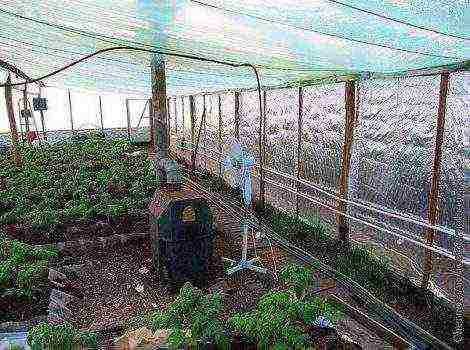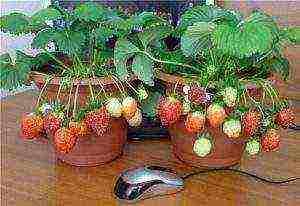Content [show]
 Watermelon and melon are thermophilic berries, their seeds germinate at home, and adult plants grow and develop intensively at temperatures from 25 to 30 ° C. Melons and gourds can withstand heat and drought well, but high humidity is destructive for them. Choosing varieties for central Russia should be carefully, taking into account the peculiarities of the climate.
Watermelon and melon are thermophilic berries, their seeds germinate at home, and adult plants grow and develop intensively at temperatures from 25 to 30 ° C. Melons and gourds can withstand heat and drought well, but high humidity is destructive for them. Choosing varieties for central Russia should be carefully, taking into account the peculiarities of the climate.
Seed preparation and seedling care
Melon is a southern and whimsical plant, so the seeds are soaked in a warm solution of potassium permanganate. The emerged specimens are discarded, since they will not sprout.
Peat cups with nutritious soil, in which 1 seed are placed, are excellent for sowing. The sprouts are watered with moderately warm settled water, after the plants acquire 3 leaves, they are taught to fresh air. Take the seedlings out to the balcony or open the window for 15 minutesgradually increasing the time to 1 hour.
Watermelon seeds are sown in a similar manner. As a rule, sowing work at home is carried out in late April or early May. In this case, the seedlings of melons and gourds move to the beds when the ground warms up enough and the threat of a return of cold weather has passed.
Young plants are in pots for about a month, which means that they need feeding during this period. For this purpose, it is good to use a complex mineral fertilizer or mullein dissolved in water. It's important to know, that in addition to proper care, the sprouts also need a sufficient amount of light - the day should be increased to 14 hours, using special lamps.
Greenhouse cultivation
Preparing the soil before planting seedlings consists in loosening it, cleaning it from weeds and warming it up. Experienced gardeners recommend growing parsley or dill in the garden before planting melons and gourds. Greens will warm the soil well, which increases the chances of success.It is also advisable to sprinkle wood ash in the greenhouse shortly before planting watermelons and melons.
Seedlings are placed in a greenhouse when it is warm outside and there is no threat of night frosts. However, if the spring is cold and rainy, then you should wait until the end of May.
Young plants are planted in pits, the depth of which depends on the size of the seedlings. The distance between them should be at least 70 cm, as the bushes grow strongly. Add some rotted cow dung to each hole and pour watermelons and melons liberally. 2 weeks after planting melons and gourds together on the beds, it's time to think about watering. Only warm water is suitable for this purpose, while avoiding droplets on the leaves.
In hot weather, plants are irrigated 3 times a week, and under normal conditions - no more than 2 times. They moisten not only the bushes themselves, but also the area adjacent to them. After watering, weeds must be removed, the soil is loosened and additional nutrition is added.
How to grow a watermelon in the middle lane (video)
Top dressing of melons and gourds
It is much more difficult to grow watermelons and melons in central Russia than in the south. Plants need mineral nutrition to accelerate their growth.
Microelements such as potassium, magnesium, phosphorus, nitrogen increase the productivity of bushes, promote the ripening of sweet and juicy berries. Adequate potassium in the soil is important, since in its presence, female flowers are well pollinated, melons and watermelons become resistant to garden diseases.
You can saturate plant roots with the following substances:
- potassium chloride (30 g);
- ammonium nitrate (10 g);
- superphosphate (40 g).
Additives are dissolved in 10 liters of warm water and introduced into moist soil. The soil saturated with valuable microelements is loosened and leveled in order to provide air access to the plant roots.
Melons and gourds respond especially well to potassium, which improves the quality of the future harvest.
Organic fertilizers are of both plant and animal origin. In them you can find all the necessary substances that are well absorbed by growing watermelons and melons. Humus is well suited for adding to the soil, it can be applied in large quantities. But bird or cow manure should be infused for several days and diluted with warm water, otherwise this fertilizer will harm the root system of plants. Feeding is allowed every 2 weeks.
Watermelons and melons also respond well to yeast nutrition. To make this fertilizer, you need regular baker's yeast:
- Take 20 g of the product and stir it in 10 liters of warm water, then infuse the mixture for 2 days.
- Next, pour the nutrient fluid into a large garden barrel of water and apply yeast top dressing as needed.

Plant formation
10 days after planting in the greenhouse, melons are tied up in the same way as cucumbers. When the watermelons reach the size of an apple, gardeners carry out the formation of lashes, leaving only 2 processes with ovaries. At the same time, organic fertilizers are applied, which are necessary for the further growth of the bush.
Lateral shoots that do not have ovaries should be removed. And the shoots with forming berries need to be pinched, leaving 3 leaves above the ovary.
When the melon has 3 true leaves, pinch the plant. On the lateral lashes, pinch the tops, enhancing the development of fruiting processes. So, leave from 3 to 5 berries on the bush, and all other ovaries are removed. Rationing of fruits is done when the side lashes acquire 5 leaves. If you do this later, the harvest will ripen later and the berries will turn out to be small and savory.
Which varieties to choose
Thanks to the efforts of breeders, it is now possible to grow melons and gourds not only in the south, but also in central Russia. The main thing is to choose the right variety. The table below shows the best varieties of watermelon with a short growing season.
| Name | Description | Ripening period |
| "Ogonyok" | Small dark green spherical watermelon, red granular flesh. Resistant to temperature drop | August |
| "Sugar baby" | The berry is green. The pulp is red and juicy with a high sugar content | August |
| "Chill" | Elongated striped berry, can be stored for a long time at home | Mid August and early September |
| "Honey giant" | A medium sized watermelon with a thick rind. The pulp is red, retains its benefits for 30 days after harvest | End of August and beginning of September |
Melons for cultivation in central Russia should be chosen early in maturity. One should not wait for large berries, since this quality is inherent only in southern varieties. Let's take a look at the very best melon varieties suitable for an unstable climate.
| Name | Description | Ripening period |
| "Cinderella" | Small oval melon, crispy and juicy flesh | Early august |
| "Roksolana" | The yellow berry is round in shape, the flesh is thick. Ripens faster in hot weather | August |
| "Collective farmer" | The berry is yellow-orange in color, has a mesh pattern on the peel. Suitable for cultivation exclusively in a greenhouse | Mid August and early September |
| "Caramel" | Yellow melon with thick flesh. Fusarium resistant | August |
The above varieties have advantages, thanks to which they are chosen by many gardeners:
- short growing season (fruiting at the end of summer);
- the ability to withstand a drop in temperature;
- resistance to garden diseases.
Melon: Care Tips (Video)
Contrary to popular belief, small watermelons and melons grown in central Russia are not inferior to southern varieties in terms of the amount of nutrients in the pulp. Newly bred melons are resistant to cold temperatures, however, the grower must monitor the humidity level in the greenhouse and feed the plants regularly.
In order not to lose the material, be sure to save it to your social network
Reviews and comments
Breeders have studied in detail the nature of heat-loving crops and developed a technology for growing them in regions with short summers. So cold-hardy and early ripening watermelons with a short growing season were bred - early and mid-early. Since then, everyone can grow this culture in central Russia, the Moscow region and even in Siberia. We will tell in the article in detail about these varieties, their cultivation features.
Optimal conditions for growing watermelons
Watermelon is a warm and light-loving culture. Seeds are able to germinate at a temperature of at least +17 degrees, but the optimum temperature is + 25-30 degrees during the day and +18 degrees at night. Watermelon is drought-resistant, reacts poorly to high air humidity, which can provoke the development of fungal diseases.
The most acceptable air humidity is 60-70%. Thus, watermelon is picky about the temperature of the soil and air, the duration of the growing season. These conditions are rather difficult to implement in central Russia, in Siberia. Therefore, the success of growing watermelons here depends on the correct choice of the variety and the provision of the necessary agricultural technology. Read also the article: → "Technology of growing watermelons in Siberia."
How to grow seedlings correctly
Early ripening variety of watermelon in the garden
In the middle lane, Moscow region, Siberia, a watermelon can be grown exclusively through seedlings. And it must be of high quality, since the harvest depends on it. The growing period for seedlings is only 30-35 days. This must be done in pots so that when planting in open ground, it does not damage the root system. It is desirable that the pots have a diameter of 10 centimeters - in this case, two plants are grown in them at once.
Before sowing, the seeds are soaked or germinated - this will shorten the germination period. To get good friendly shoots, seeds need to provide a temperature of + 27-30 degrees during the day and + 18-20 degrees at night. Seeds for seedlings should be sown around mid-April. Seedlings should grow in the sunniest part of the apartment - for example, on a windowsill on the south side.
Tip # 1. The quality of seedlings will increase if they are grown on a glazed and insulated loggia. At the same time, it is imperative to monitor the temperature.

Early ripening popular watermelon variety Sugar baby
During the cultivation of seedlings, 2 additional fertilizing with complex mineral fertilizers are carried out. The arrangement of plants is important: they should not touch the leaves, so from time to time the pots are pushed apart. Seedlings ready for planting should have 3-5 true leaves. A week before planting, the seedlings need to be hardened: the daytime temperature drops to 15-17 degrees, the nighttime temperature drops to 12-15 degrees. Plants are also heavily ventilated.
For regions with cool and short summers, early ripening varieties of watermelons are most suitable. They mature in just 60-80 days.Usually, these varieties of watermelons are small - they weigh no more than 3 kilograms - but they are very sweet and tasty. They have a thin peel, so they cannot be stored for a long time, and they are vulnerable to mechanical damage.
Early ripening varieties of watermelons
The most popular varieties are presented in the table with a description of the characteristics and ripening periods:
| Variety name | Characteristic |
| Prince Albert F1 | Early ripening fruitful variety. Ripening period 75-80 days. Fruits with thin skin, yellow, small, with a delicious taste: the red pulp is very juicy, sweet. The mass of one watermelon is 2-3 kg. Storage is short. Best consumed fresh. |
| Prince Hamlet F1 | The variety is early maturing. Ripens in 70-80 days. Fruits are medium in size, round, striped, with thin skin. The seedless pulp is very juicy and sweet, bright yellow. The weight of one watermelon is 1-2 kg. The variety can be grown in regions with unfavorable climatic conditions. It is immune to disease. |
| Sugar baby (Suga baby) | Early ripening popular variety. Ripening period 65-80 days. It is unpretentious in cultivation, resistant to difficult climates and various diseases. Dark green fruits have a black tint. The sizes are average. The shape is round. The dark red pulp is very tender, sweet, sugar, juicy. Watermelon weight 2-5 kg. The variety has excellent commercial qualities, excellent immunity to diseases. Cold resistant. |
| SRD-2 (Very early Dyutina-2) | The variety is very early ripening: ripening period is 55-60 days. The fruits are elongated and rounded. Their average weight is 5-9 kg. The surface is slightly ribbed, smooth with dark green narrow prickly stripes on a light green background. Hard, thick skin. The red pulp is sweet, juicy. The variety is resistant to melon aphids, powdery mildew, anthracnose. |
| Skorik | The ripening period of the variety is about 2 months. The fruits are large, striped, with black seeds. The shape is spherical. The rind is smooth. The pulp is dense, very tasty, juicy, aromatic, with fibers. Weight 1-4 kg. High-yielding variety. |
| Reddish | The growing season is 65-80 days. The fruits are round. The peel is white with narrow green longitudinal stripes. Their weight is about 8 kg. The average yield is 50 t / ha. Raspberry pulp is coarse-grained, tasty, with small seeds. The variety is resistant to anthracnose, fusarium leaf wilt. |
| Producer | Early ripening variety - ripening period 62-85 days. Fruit weight is about 5 kg. Their shape is spherical. The pulp is red with brown blotches, with small seeds. The variety is resistant to disease. Productivity is 20-50 t / ha. |
Varieties of early ripening watermelons for the middle strip
There are many early ripening varieties that have their own characteristics and require a different approach to cultivation.
It is very important to find the right variety here. For the cultivation of watermelons in central Russia, extremely early ripening varieties are suitable. You should not pay much attention to the size of the fruits, here they still will not grow large due to climatic conditions. Transportability and fruit color are also not important when choosing a variety. In the description of the variety, attention should be paid to the number of days from fruit setting to ripening.
It is advisable to give preference to varieties that have time to ripen, taking into account the characteristics of the climate of the middle zone and have excellent taste. You can safely choose the following varieties: the above-described Sugar Baby (Suga baby), as well as the Gift to the North F1, Krimstar F1, Pink Champagne F1, Charleston near Moscow, Cinderella. And further:
| Variety name | Characteristic |
| Twinkle | Early variety, very popular. High in sugar. High-yielding. Dark green, almost black fruits are small - weight up to 2.5 kg, juicy, very sweet. The shape is spherical. The variety is winter-hardy, resistant to diseases. |
| Lady F1 | Ultra early hybrid. Vegetation lasts 2 months. Fruits are oblong, striped. With proper care, they can grow up to 12-15 kg. Juicy, sugary. They are immune to fusarium. They tolerate a lack of moisture in the soil. The fruits are not prone to cracking. |
| Crimson Sweet F1 | Medium early variety, bred by American breeders. All of its characteristics are excellent. The average size of the fruit reaches 8-11 kg. Striped, rounded, sometimes slightly elongated. Delicious, sweet, bright red inside. The variety is resistant to fusarium and lack of moisture. |
| Romanza F1 | Hybrid, medium early, of Dutch selection. It is very popular with gardeners as it is very sweet. Small fruits weigh up to 7.5 kg. They have a rounded shape. Striped. They have excellent keeping quality, which is not typical for early varieties. |
| Peasant | In regions with cold climates, this variety is used very often. The bark of the fruit is thick and strong. Therefore, the variety is cold-resistant. Transportable. The fruits are elongated. Sweet, juicy. |
Early ripening varieties of watermelons for the Moscow region
The key to a good harvest is the right choice of watermelon seeds. If the ripening period indicated on the package exceeds 85 days, then these seeds are not suitable for growing in the Moscow region, since the summer here is quite short, and watermelons are extremely demanding for light and heat. Read also the article: → "Features of growing watermelons in the Moscow region." The following varieties and hybrids of watermelons are suitable for cultivation in this region:
| Variety name | Characteristic |
| Seedless yellow F1 | The hybrid is considered a novelty among seedless varieties. The fruit has a round shape, medium size, thin rind, juicy flesh with a touch of mango flavor. This early ripe hybrid is resistant to various diseases. It is consumed fresh, watermelon honey, candied fruits, and various desserts are prepared from it. |
| Moon and Stars F1 | An early ripe hybrid. Also new. Has an original appearance: round like the moon with distinct specks on a dark surface. The pulp is very tasty and has a honey color and taste. Almost seedless. |
| A gift to the north F1 | Super-early hybrid with a ripening period of about 75 days. Fruit weight reaches 10 kg. High-yielding hybrid. Drought and disease resistant. It has a juicy, crispy pulp, very sweet. Transportable. |
| Gift of the Sun | This variety has a golden yellow skin. Ripening period 68-73 days. Inside it is bright red, juicy, delicately grainy. |
| Charleston near Moscow | One of the earliest hybrids. The time from sowing to harvesting is 80 days. The fruits are oval, large. The mass of one is an average of 10 kg. They have a dark green color, smooth shiny bark. The inside is bright red, dense, sweet, delicious. |
Watermelon varieties for growing in Siberia
For colder climates, it is better to choose more resistant varieties.
The key to successful cultivation of watermelons in Siberia is:
- the right choice of varieties;
- competent agricultural technology;
- proper weather conditions.
The last factor is the most difficult to accomplish. Therefore, it is necessary to independently create the appropriate conditions: to grow seedlings with artificial supplementary lighting in a greenhouse or partially under a film. By the way, there is enough sun in Siberia: scientists have calculated the total amount of solar heat in Omsk and Crimea. So in Siberian Omsk there were more sunny days than in the south, where it rains more often, fogs occur. Although the weather in Siberia is also unpredictable, so you need to be prepared for its whims.
In the northern regions of Russia, there are many people who want to grow watermelons on their plots. For them, breeders have developed hybrid varieties of this berry - they are perfectly adapted for ripening in Siberia. Read also the article: → "Crimson Sweet" or "Raspberry Sugar" - early ripening watermelon ". In addition to the above-described varieties of Ogonyok and Crimson Sweet, these are:
| Variety name | Characteristic |
| Ultra early | Early ripening variety. The fruits are not large. Weight 2-4 kg. Inside is bright scarlet. The taste is very sweet. For germination, seeds are planted in early May. |
| Siberian | The variety is specially bred for Siberia. Unpretentious care. Resistant to temperature changes. Refers to early ripening varieties. The fruits weigh up to 5 kg. The inside is very sweet and juicy. |
| Crimson Wonder | Medium early grade. Grows very well in Siberia. Ripens in 85 days.Fruit weight reaches 10 kg. The skin is pale green with dark stripes. Inside, the fruit is red, delicate in taste, aromatic. Disease resistant and easy to transport. |
| Madera F1 | It is considered one of the best early maturing hybrids. Resistant to disease. Large fruits weigh 6-8 kg, round in shape, with light green stripes. The pulp is bright red, crispy, juicy. Fruits are poured in 35-40 days. Inside, sweet, delicious, with a delicate aroma. |
| F1 sympathy | Super early hybrid. Fruits are round, large, dark green striped. Weight 6-10 kg. Pour in 35-40 days. Inside are sweet, juicy, aromatic. |
| Crimson Gloria F1 | An early hybrid. Fruits are round, striped, weighing 12-15 kg. Resistant to disease. Possesses good keeping quality and transportability. |
| Astrakhan | The variety is mid-season. Fruits are globular, large, of excellent quality. Inside are sweet, dense, juicy. Well transported and stored. |
| Charleston gray | Medium late variety. The fruits are large, elongated. Weight up to 12 kg. The variety is resistant to anthracnose and fusarium. Possesses excellent keeping quality, transportability. He has excellent taste. |
Tip # 2. The most important thing in growing watermelons in Siberia is the selection of varieties. Recently, you can often choose among the seeds of watermelons of foreign manufacturers.
The cultivation process begins at the end of April. The seeds are soaked in a solution of potassium permanganate for 20 minutes, then they are replaced with a solution of a growth stimulator or micronutrient fertilizers. Leave the seeds in it warm for a day. After that, the seeds are hardened for 5-7 days with variable temperatures: during the day - on the lower shelf of the refrigerator, at night - at room temperature.
In order for the seeds to sprout quickly and amicably, experienced gardeners chip off the top of the seed shell on one side. At a temperature of 26-28 degrees, a change of 2-3 days can withstand - it is after this time that they will hatch. If you do not do this operation with the seeds, then the seedlings will appear only after 2 weeks.
Seedlings are grown in pots 7 centimeters high in light fertile soil.
It is important that the seedlings are strong and do not stretch out. For this, 4-5 days must pass after germination. When the cotyledon leaves come to the surface, the pots need to be rearranged on a glazed loggia or in a place where it is most light, and the temperature is about 15-17 degrees. Then the temperature is raised during the day - up to 22 degrees, at night - up to 18.
During the growth of seedlings, it is fed 2-3 times with potassium permanganate and trace elements. Water it sparingly so that the roots do not rot. It should be planted in the ground after the end of frost - in the first decade of June.
Heading "Question-answer"
Question. How to plant watermelon seedlings in the suburbs?
In this region, watermelons are grown only through seedlings from mid-April. They take care of it in the same way as for pumpkin and cucumber seedlings. If you leave the watermelons to grow in the greenhouse, then the lashes must be tied vertically, after placing them in a supporting mesh. The best harvest is obtained if the seedlings are planted in open ground under a shelter. And the main condition is a good summer. If it turns out to be rainy and not hot, you should not expect high-quality watermelons.
It is no longer news to anyone that melons and watermelons can be successfully grown in the Middle Belt, in the Urals, in Siberia, observing a certain, rather simple agricultural technique. And in the first place in the list of secrets of successful cultivation of watermelons is the correct choice of variety.
The best varieties of watermelons for the middle lane are early ripening varieties, relatively resistant to temperature drop and major diseases, not afraid of drought, growing well in the open field. Some gardeners like mid-early varieties: they last longer, and who doesn't dream of getting their own watermelon from the cellar for the New Year's table? With all this, I would like to grow sweet, sugar and more or less large watermelons.
We offer you a selection of the most popular, time-tested varieties of watermelons, as well as new generation hybrids that are best suited for growing in the middle lane, in the Urals and Siberia.
Watermelon variety Ogonyok
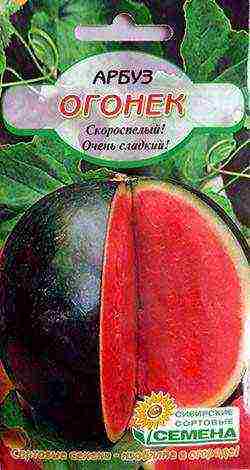 An early ripe variety, the period from germination to the first harvest of fruits is 71-87 days. The fruit is spherical, small, weighing 1.7-2.3 kg. The bark is thin, shiny, smooth or slightly segmented, dark green in color with a hidden pattern. The pulp is orange-red, tender, juicy, sweet. The seeds are small. An unpretentious, cold-resistant variety, relatively resistant to anthracnose, moderately affected by powdery mildew. It is very popular with gardeners, however, it is practically not stored.
An early ripe variety, the period from germination to the first harvest of fruits is 71-87 days. The fruit is spherical, small, weighing 1.7-2.3 kg. The bark is thin, shiny, smooth or slightly segmented, dark green in color with a hidden pattern. The pulp is orange-red, tender, juicy, sweet. The seeds are small. An unpretentious, cold-resistant variety, relatively resistant to anthracnose, moderately affected by powdery mildew. It is very popular with gardeners, however, it is practically not stored.
Watermelon variety near Moscow Charleston F1
 An early ripe hybrid, the period from germination to the start of harvesting is about 80 days. Fruits are large, oval, weighing 8-10 kg. The crust is smooth, shiny, dark green. The pulp is bright red, firm, sweet, without fibers. The taste is excellent.
An early ripe hybrid, the period from germination to the start of harvesting is about 80 days. Fruits are large, oval, weighing 8-10 kg. The crust is smooth, shiny, dark green. The pulp is bright red, firm, sweet, without fibers. The taste is excellent.
Watermelon variety Ultra early
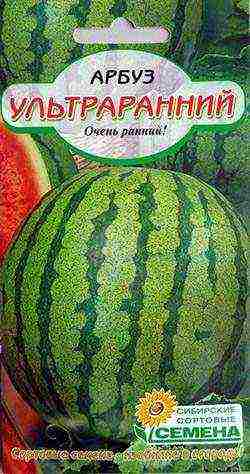 Early ripening variety, from germination to the beginning of fruiting - 80 days. Fruits are round, dark green with dark stripes, weighing from 2.5 to 6 kg. The pulp is bright red, tender, grainy, very sweet. The variety is resistant to low temperatures, and is especially valued for its moderate branching of shoots and compactness of plants, which allows them to be grown in small areas.
Early ripening variety, from germination to the beginning of fruiting - 80 days. Fruits are round, dark green with dark stripes, weighing from 2.5 to 6 kg. The pulp is bright red, tender, grainy, very sweet. The variety is resistant to low temperatures, and is especially valued for its moderate branching of shoots and compactness of plants, which allows them to be grown in small areas.
Watermelon variety Crimson Sweet
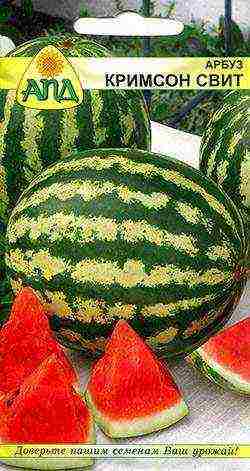 Early variety, ripening time from full shoots - 67-82 days. Fruits are round in shape, weighing from 3 to 8 kg. The bark is thin, smooth, shiny with alternating dark and light green stripes. The pulp is bright red, crispy, tender, sweet, rich in taste. The variety is resistant to fusarium, anthracnose and powdery mildew.
Early variety, ripening time from full shoots - 67-82 days. Fruits are round in shape, weighing from 3 to 8 kg. The bark is thin, smooth, shiny with alternating dark and light green stripes. The pulp is bright red, crispy, tender, sweet, rich in taste. The variety is resistant to fusarium, anthracnose and powdery mildew.
Watermelon variety Kai F1
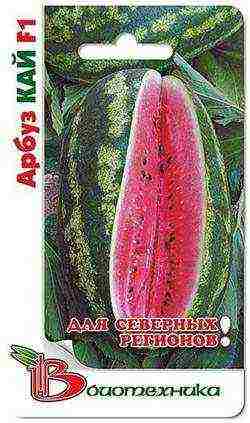 A popular early ripening hybrid, the ripening period from germination is 70-75 days. The fruit is oval-elongated, weighing 7-10 kg. The rind is very thin, light green with longitudinal dark green intermittent stripes. The pulp is bright raspberry, juicy, sugary, aromatic. The seeds are small and there are very few of them. The hybrid was bred specifically for cultivation in the northern regions, and has proven itself very well in the countries of northern Europe.
A popular early ripening hybrid, the ripening period from germination is 70-75 days. The fruit is oval-elongated, weighing 7-10 kg. The rind is very thin, light green with longitudinal dark green intermittent stripes. The pulp is bright raspberry, juicy, sugary, aromatic. The seeds are small and there are very few of them. The hybrid was bred specifically for cultivation in the northern regions, and has proven itself very well in the countries of northern Europe.
Sorento F1 watermelon variety
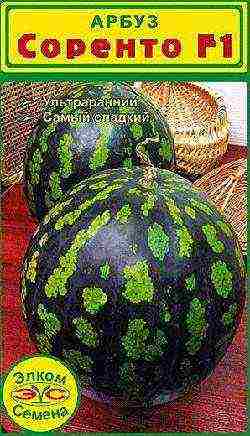 Early hybrid, ripening period from full shoots 65-76 days. Fruits are spherical, dark green in color with light green spots, reaching a weight of 5 kg. The pulp is deep red, very juicy and sweet. Seeds are medium, brown with dots. The plant is of medium climbing, each tying an average of 2 fruits. The hybrid is resistant to fusarium.
Early hybrid, ripening period from full shoots 65-76 days. Fruits are spherical, dark green in color with light green spots, reaching a weight of 5 kg. The pulp is deep red, very juicy and sweet. Seeds are medium, brown with dots. The plant is of medium climbing, each tying an average of 2 fruits. The hybrid is resistant to fusarium.
Watermelon variety Siberian giant
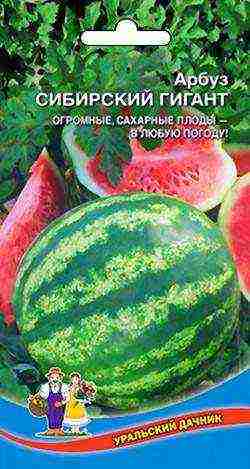 An early fruitful variety. Fruits are round, weight can reach 7 kg. The rind is green, with dark green prickly stripes. The pulp is dense, red, tender, juicy, very sweet. Seeds are small, brown, speckled. The variety is characterized by cold resistance, good transportability, keeping quality.
An early fruitful variety. Fruits are round, weight can reach 7 kg. The rind is green, with dark green prickly stripes. The pulp is dense, red, tender, juicy, very sweet. Seeds are small, brown, speckled. The variety is characterized by cold resistance, good transportability, keeping quality.
Skorik watermelon variety
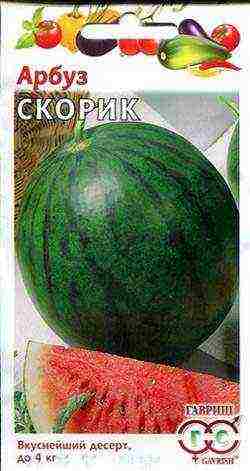 Mid-early variety, the period from germination to the removal of the first fruits is 80-100 days. Fruits are spherical, average weight 2-4 kg. The bark is light green with dark green broken lines, smooth, of medium thickness. The pulp is fragrant, juicy with a delicate, sweet taste, red. The seeds are small. The variety is resistant to powdery mildew and bacterial spotting, is well stored, transportable.
Mid-early variety, the period from germination to the removal of the first fruits is 80-100 days. Fruits are spherical, average weight 2-4 kg. The bark is light green with dark green broken lines, smooth, of medium thickness. The pulp is fragrant, juicy with a delicate, sweet taste, red. The seeds are small. The variety is resistant to powdery mildew and bacterial spotting, is well stored, transportable.
Watermelon variety Beijing Joy Gourmet F1
 An early hybrid, from germination to ripening, takes 80-90 days, from fruit setting to ripening 26 days. The fruits are beautiful, round, even, weighing up to 3 kg. The bark is thin, elastic, green with dark stripes. The pulp is red-raspberry, sugar. The variety is well stored, retains the density of the pulp during storage and has a high yield. In addition to Delicacy, the series "Beijing Joy" also presents: Beijing Joy Lying, Farmer, Peasant. All of them are early ripening, excellent taste and suitable for growing in the middle lane.
An early hybrid, from germination to ripening, takes 80-90 days, from fruit setting to ripening 26 days. The fruits are beautiful, round, even, weighing up to 3 kg. The bark is thin, elastic, green with dark stripes. The pulp is red-raspberry, sugar. The variety is well stored, retains the density of the pulp during storage and has a high yield. In addition to Delicacy, the series "Beijing Joy" also presents: Beijing Joy Lying, Farmer, Peasant. All of them are early ripening, excellent taste and suitable for growing in the middle lane.
Watermelon variety Gift to the North F1
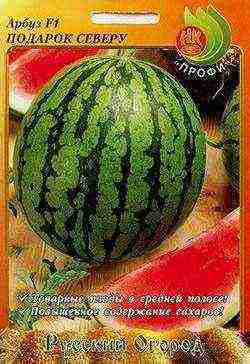 An early hybrid, the period from full germination to the beginning of harvest is 75-85 days. Fruits are roundish, with a maximum weight of 10 kg. The peel is smooth, green with dark green broken stripes. The pulp is juicy, crispy, rich red color, with a high sugar content. The hybrid is characterized by increased transportability, disease resistance, the ability to give a high yield in drought conditions.
An early hybrid, the period from full germination to the beginning of harvest is 75-85 days. Fruits are roundish, with a maximum weight of 10 kg. The peel is smooth, green with dark green broken stripes. The pulp is juicy, crispy, rich red color, with a high sugar content. The hybrid is characterized by increased transportability, disease resistance, the ability to give a high yield in drought conditions.
Watermelon variety Atamansky
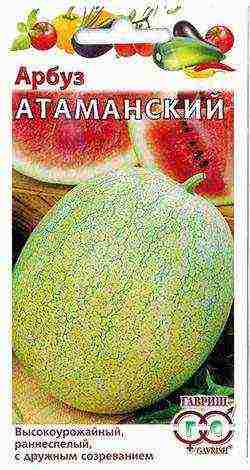 An early high-yielding variety, ripening period from germination to harvest 68-88 days. The fruit is round-elliptical with light green bark, smooth, average weight 3-4 kg. The pulp is intensely red, grainy, tender and very sweet. The variety is distinguished by drought resistance, weak susceptibility to fusarium and anthracnose.
An early high-yielding variety, ripening period from germination to harvest 68-88 days. The fruit is round-elliptical with light green bark, smooth, average weight 3-4 kg. The pulp is intensely red, grainy, tender and very sweet. The variety is distinguished by drought resistance, weak susceptibility to fusarium and anthracnose.
Watermelon variety Sugar baby (Suga Baby)
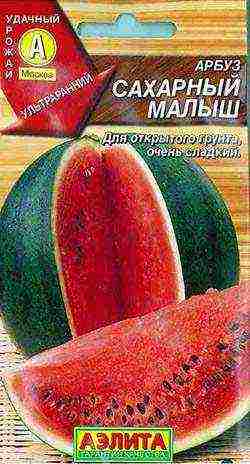 An early, intensively growing variety. Ripens in 75-80 days after germination. The plant is medium-growing. The fruit is round. The surface is dark green with thin stripes. Weight 4-6 kg. The pulp is bright red, tender, grainy, very sweet. Fruit transportability is good. The variety is resistant to disease.
An early, intensively growing variety. Ripens in 75-80 days after germination. The plant is medium-growing. The fruit is round. The surface is dark green with thin stripes. Weight 4-6 kg. The pulp is bright red, tender, grainy, very sweet. Fruit transportability is good. The variety is resistant to disease.
Watermelon variety Sibiryak-97
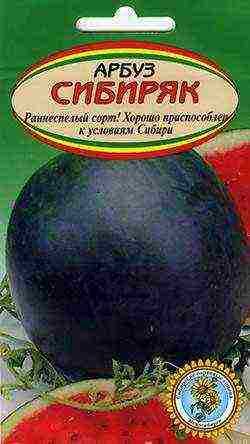 Ultra-early ripening variety, ripening period - 75-82 days. Fruits are round, with an average weight of 4.5 kg. The crust is thin, dark green with barely noticeable stripes. The pulp is bright red, tender, very sweet. The variety is valued for its resistance to temperature extremes, the ability to set fruits in cold summers and excellent taste.
Ultra-early ripening variety, ripening period - 75-82 days. Fruits are round, with an average weight of 4.5 kg. The crust is thin, dark green with barely noticeable stripes. The pulp is bright red, tender, very sweet. The variety is valued for its resistance to temperature extremes, the ability to set fruits in cold summers and excellent taste.
Watermelon variety Medovik
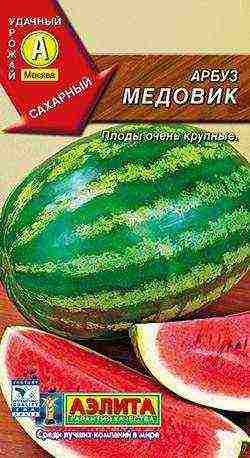 Early ripening variety, ripening period from germination to maturity 78-90 days. The fruit is broadly elliptical, smooth, up to 6 kg. The bark is of medium thickness, light green, the stripes are dark green of medium width. The pulp is grainy, juicy, very sweet. The variety has good keeping quality, it is stored until the new year.
Early ripening variety, ripening period from germination to maturity 78-90 days. The fruit is broadly elliptical, smooth, up to 6 kg. The bark is of medium thickness, light green, the stripes are dark green of medium width. The pulp is grainy, juicy, very sweet. The variety has good keeping quality, it is stored until the new year.
Watermelon variety Superearly Dyutina (SRD) and SRD 2
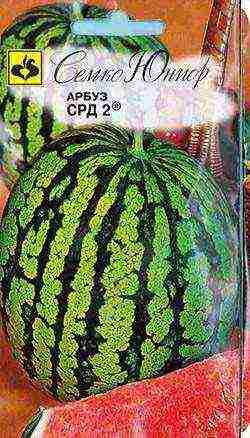 An early ripening variety, fruit ripening period from full shoots is 58-60 days. The fruit is round, slightly segmented, weighing from 4 to 9 kg. The bark is light green with dark green prickly stripes, 1.3-1.5 cm thick, flexible, light green in section. The pulp is red, dense, grainy, of excellent taste. Seeds are white with a grayish tinge. The variety is distinguished by the limited development of lateral shoots, as well as the ability to maintain marketability of fruits for 25 days after removal.
An early ripening variety, fruit ripening period from full shoots is 58-60 days. The fruit is round, slightly segmented, weighing from 4 to 9 kg. The bark is light green with dark green prickly stripes, 1.3-1.5 cm thick, flexible, light green in section. The pulp is red, dense, grainy, of excellent taste. Seeds are white with a grayish tinge. The variety is distinguished by the limited development of lateral shoots, as well as the ability to maintain marketability of fruits for 25 days after removal.
Watermelon variety Krimstar F1
 An early hybrid, the period from full germination to the first harvest of fruits 73-89 days. The fruit is round, smooth, weighing 4-5.5 kg. The rind is green, with dark green stripes, thin, greenish-white on the cut. The pulp is dark red, tender, of excellent taste, with a high sugar content. The variety is resistant to anthracnose and the ability to maintain marketability for 1.5 months after picking.
An early hybrid, the period from full germination to the first harvest of fruits 73-89 days. The fruit is round, smooth, weighing 4-5.5 kg. The rind is green, with dark green stripes, thin, greenish-white on the cut. The pulp is dark red, tender, of excellent taste, with a high sugar content. The variety is resistant to anthracnose and the ability to maintain marketability for 1.5 months after picking.
Watermelon variety Siberian lights
 An early ripening variety, the period from full germination to the removal of the first fruits is 75-95 days. Fruits are spherical, weighing up to 5 kg. The bark is dark green, thin. The pulp is bright red, sweet, juicy. The seeds are small. The variety is resistant to fusarium, low temperatures and drought. Fruit transportability is good.
An early ripening variety, the period from full germination to the removal of the first fruits is 75-95 days. Fruits are spherical, weighing up to 5 kg. The bark is dark green, thin. The pulp is bright red, sweet, juicy. The seeds are small. The variety is resistant to fusarium, low temperatures and drought. Fruit transportability is good.
Watermelon variety Sweet diamond
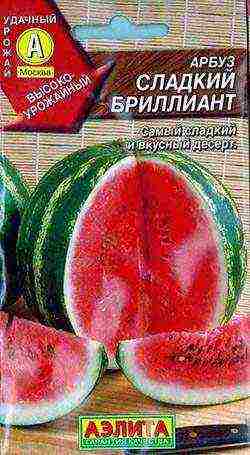 Early maturing, high-yielding variety (65-75 days from germination to ripening). Fruits are round, slightly elongated, weighing 3-6 kg. The bark is striped, thin. The pulp is dark red, very sweet, with a high sugar content. The variety is distinguished by excellent transportability, resistance to fusarium and the ability to produce crops in all weather conditions.
Early maturing, high-yielding variety (65-75 days from germination to ripening). Fruits are round, slightly elongated, weighing 3-6 kg. The bark is striped, thin. The pulp is dark red, very sweet, with a high sugar content. The variety is distinguished by excellent transportability, resistance to fusarium and the ability to produce crops in all weather conditions.
Watermelon variety Photon
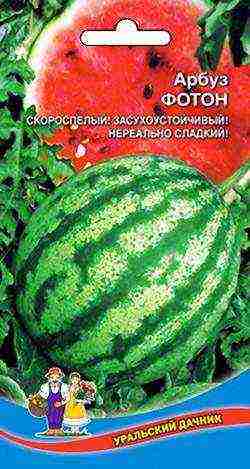 A mid-early variety of watermelon, the period from germination to collection of the first fruits is 82-105 days. The fruit is round, slightly elongated, the average weight is 2-4 kg. The bark is bright green with dark green prickly stripes. The pulp is red, sweet, juicy, with an excellent dessert taste. The variety is resistant to low temperatures and diseases, especially appreciated for its good keeping quality.
A mid-early variety of watermelon, the period from germination to collection of the first fruits is 82-105 days. The fruit is round, slightly elongated, the average weight is 2-4 kg. The bark is bright green with dark green prickly stripes. The pulp is red, sweet, juicy, with an excellent dessert taste. The variety is resistant to low temperatures and diseases, especially appreciated for its good keeping quality.
Watermelon variety Miracle berry
 Early ripening variety, from germination to fruit ripening 80-95 days.Fruits are round, weighing 2-4 kg. The bark is green with dark green stripes, thin. The pulp is lemon-yellow, sweet, honey-like. The variety is valued for its unpretentious cultivation, a high percentage of sugar in the extraordinary yellow pulp.
Early ripening variety, from germination to fruit ripening 80-95 days.Fruits are round, weighing 2-4 kg. The bark is green with dark green stripes, thin. The pulp is lemon-yellow, sweet, honey-like. The variety is valued for its unpretentious cultivation, a high percentage of sugar in the extraordinary yellow pulp.
Watermelon variety Gift of the sun
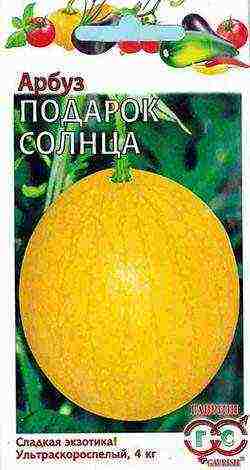 Ultra early ripening variety, 67-73 days from germination to ripening of the first fruits. Fruits are round, slightly elongated, smooth, average weight 2-4 kg. The bark is golden yellow with faint stripes. The pulp is pink-red, soft-grained, juicy, sweet.
Ultra early ripening variety, 67-73 days from germination to ripening of the first fruits. Fruits are round, slightly elongated, smooth, average weight 2-4 kg. The bark is golden yellow with faint stripes. The pulp is pink-red, soft-grained, juicy, sweet.
In the following articles, we will talk about agricultural techniques for growing watermelons in an unsuitable climate for this berry, we will understand the intricacies of planting and molding, we will learn how to grow not just "watermelons", but large full-fledged fruits. Stay with us!
Please rate the article. We tried very hard:
